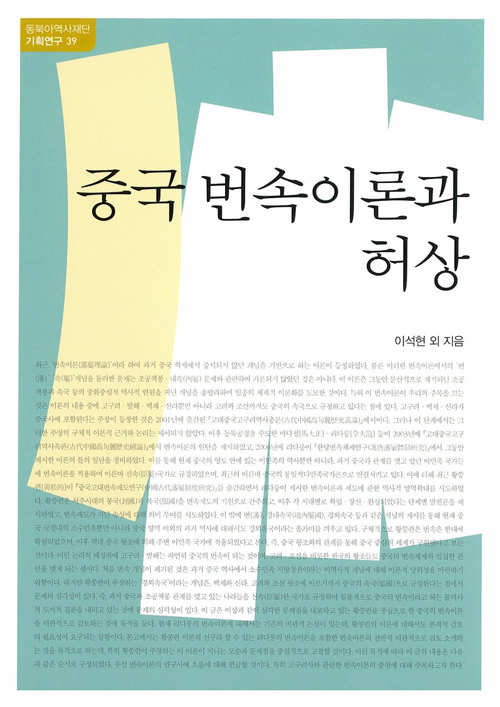Publication
- Date2011.06.20
- Hit939

1. All rights of the contents and the electronic files in the Webpage are reserved for the Northeast Asia History Foundation.
2. No part of the Webpage may be reproduced, stored in retrieval system, or transmitted, in any form or by any means, without the prior permission.
Title : (Northeast Asian History Foundation Research Series 39)
Illusion of Chinese Fanshu Theory
Lee, Suk Hyun et al.
Small Octavo Edition / 240 pages / 2010 / KRW11,000 (US$9) / ISBN 978-89-6187-183-9
The title analyzes China's Fanshu theory and presents logics to overcome it, by analyzing the most important studies of Fanshu theory ― Li Dalong (李大龍)'s
Table of Contents
• Critical review on China's Fanshu theory / Lee, Suk Hyun
Ⅰ. Introduction
Ⅱ. Affiliation of Goguryeo and Fanshu theory
Ⅲ. Critical review of Fanshu theory
1_ Li Dalong's Fanshu concept
2_ Li Dalong's Fanshu theory
3_ Huang Songjun's Fanshu theory
Ⅳ. Criticism regarding Huang Songjun's Fanshu theory
1_ Sino-centric perspective of history
2_ Local autonomy and the issue of national autonomy
3_ Defining concepts regarding historical facts
4_ Regims of ethnic minorities and the issue of subject states outside borders
5_ Facts and concepts about Fanshu
6_ Issue of understanding the concept of subject state
7_ Huang Songjun's theory and Korean peninsula
Ⅴ. Conclusion
• Perception of the world and Fanshu system in Han Dynasty / Pang, Hyang Sook
- Examination on ancient Fanshu system and ideology
Ⅰ. Introduction
Ⅱ. Establishment of ancient Fanshu system
1_ Enfeoffment system of Western Zhou
2_ Enfeoffment and nobility investiture system in the Spring and Autumn period and the Warring States period
3_ Fanshu system in Han Dynasty
4_ Duhu (都護) system in the Wei, Jin, Southern & Northern Dynasties period
Ⅲ. Ideological foundation of Fanshu theory and the perspective of the world
1_ Fanshu(藩屬) organization represents the nation
2_ Investiture ― the most important part of Fanshu system
3_ Development of the concept of "Fanshu" in history
4_ Perspective of the world in Fanshu theory
Ⅳ. Conclusion
• Perception of the world and Fanshu system in Tang Dynasty / Kim, Sung Han
Ⅰ. Introduction
Ⅱ. Perception of the world and Sino-barbarian dichotomy in Tang Dynasty
1_ Li Dalong's understanding of the perception of the world and Sino-barbarian dichotomy in Tany Dynasty
2_ Perception of the world in Tang Dynasty and affiliation of Goguryeo
Ⅲ. Concept of Fanshu in Tang Dynasty
1_ Chinese scholars' Fanshu theory
2_ Fanshu system in Tang Dynasty
Ⅳ. Conclusion
• Critical review of Fanshu system in Ming Dynasty / Min, Gyong Jun
Ⅰ. Introduction
Ⅱ. Logical organization of Fanshu system in Ming Dynasty
Ⅲ. Criticism on logics of Fanshu system in Ming Dynasty
1_ Investiture of Tribe Fanwang(同姓藩王) and Fanwangfu(藩王府) (부연 설명 필요합니다)
2_ Dusiweisuo System(都司衛所制) in Eastern Liao and rule over Jurchens
3_ Rule over Tibet and tributary system
4_ Rule over tribes in the western/southern region and Tusi (土司) system
5_ Subject states outside borders and tributary relations
Ⅳ. Conclusion
• Fanshu system in Qing Dynasty and its characteristics / Lee, Young Ok
- Critical review on
Ⅰ. Introduction
Ⅱ. Errors in basic terms and premises
1_ Basic terms : Fanshu, Fanbu, Shuguo (subject state)
2_ Premises : unification war and Fanshu system
Ⅲ. Description of topics and fallacy of the point of view
1_ Repression of the Revolt of the Three Feudatories and restoration of Taiwan
2_ Unification in the Heilongjiang region and annexation of Mongolia
3_ Territorial expansion and jurisdiction of Fanbu and frontiers (bianjiang)
4_ Jurisdiction of subject states and establishment of Lifan Yuan (理藩院)
Ⅳ. Conclusion
- No Data.
